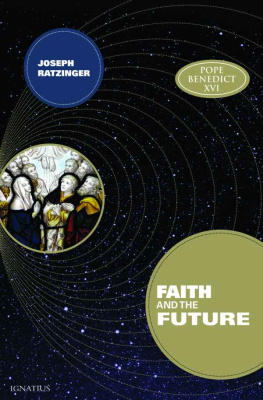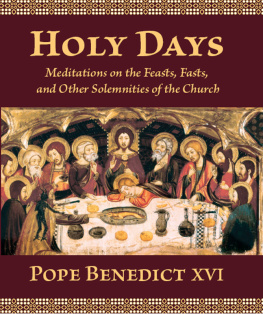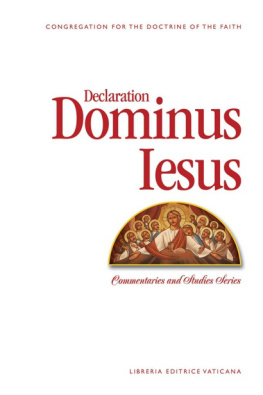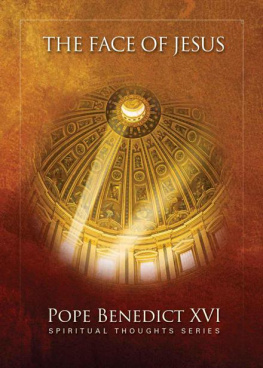Benedict XVI - On the Way to Jesus Christ
Here you can read online Benedict XVI - On the Way to Jesus Christ full text of the book (entire story) in english for free. Download pdf and epub, get meaning, cover and reviews about this ebook. year: 2005, publisher: Ignatius Press, genre: Religion. Description of the work, (preface) as well as reviews are available. Best literature library LitArk.com created for fans of good reading and offers a wide selection of genres:
Romance novel
Science fiction
Adventure
Detective
Science
History
Home and family
Prose
Art
Politics
Computer
Non-fiction
Religion
Business
Children
Humor
Choose a favorite category and find really read worthwhile books. Enjoy immersion in the world of imagination, feel the emotions of the characters or learn something new for yourself, make an fascinating discovery.
- Book:On the Way to Jesus Christ
- Author:
- Publisher:Ignatius Press
- Genre:
- Year:2005
- Rating:5 / 5
- Favourites:Add to favourites
- Your mark:
- 100
- 1
- 2
- 3
- 4
- 5
On the Way to Jesus Christ: summary, description and annotation
We offer to read an annotation, description, summary or preface (depends on what the author of the book "On the Way to Jesus Christ" wrote himself). If you haven't found the necessary information about the book — write in the comments, we will try to find it.
On the Way to Jesus Christ — read online for free the complete book (whole text) full work
Below is the text of the book, divided by pages. System saving the place of the last page read, allows you to conveniently read the book "On the Way to Jesus Christ" online for free, without having to search again every time where you left off. Put a bookmark, and you can go to the page where you finished reading at any time.
Font size:
Interval:
Bookmark:
ON THE WAY TO JESUS CHRIST
JOSEPH CARDINAL RATZINGER
Translated by Michael J. Miller
IGNATIUS PRESS SAN FRANCISCO
Title of the original German edition
Unterwegs zu Jesus Christus
2004 by Sankt Ulrich Verlag, GmbH
Augsburg, Germany
Front cover photograph:
Joseph Cardinal Ratzinger
(now Pope Benedict XVI)
Celebrating a Mass in Santa Maria in Trastevere, Rome
during his 75th birthday, April 19, 2002
CATHOLICPRESSPHOTO
Back cover art:
Christs Appearance behind Locked Doors
Duccio (di Buoninsegna) (c. 1260-1319)
From the upper section of the Maesta altarpiece.
Museo dellOpera Metropolitana, Siena, Italy
Scala / Art Resource, New York
Cover design by Roxanne Mei Lum
2005 Ignatius Press, San Francisco
All rights reserved
ISBN 978-1-58617-124-7 (HB)
ISBN 1-58617-124-0 (HB)
ISBN 978-1-58617-036-3 (PB)
ISBN 1-58617-036-8 (PB)
Library of Congress Control Number 2004103530
Printed in the United States of America
CONTENTS
ON THE WAY TO JESUS CHRIST
THE FIGURE OF THE REDEEMER
EPILOGUE
FOREWORD
In the midst of the crisis that has befallen Christianity in many parts of the world, the figure of Jesus of Nazareth remains astonishingly current. Even outside of Christianity he appeals to people: Islam recognizes him as a prophet; in India many people have set up an image of Jesus in their house. The Christ of the Sermon on the Mount, who moved Gandhi so deeply, has become for many non-Christians there a messenger of Gods goodness, in whom the light of eternity shines into the world. The story related by the Synoptic Gospels about the suffering woman who touched Jesus garments from behind and was thus healed surely takes place even today again and again in many different ways.
Yet concurrent with this manifold presence of the figure of Jesus, it is disturbing to note that, within Christianity itself, Christology has been losing its meaning. It started with the effort to rediscover the man Jesus behind the gilded background of dogma, to return to the simplicity of the Gospels. Of course, it quickly became evident that the figure of Jesus in the Gospels cannot be reduced to that of a bland philanthropistthat precisely the Jesus of the Gospels, too, bursts open the framework of what is merely human, posing questions and demanding decisions that challenge man to the very depths of his soul. And so it became necessary then to pick and choose even in the Gospels themselves, in order to find a little consolation and not be exposed to any disturbance of ones own world view. Today in broad circles, even among believers, an image has prevailed of a Jesus who demands nothing, never scolds, who accepts everyone and everything, who no longer does anything but affirm us: the perfect opposite of the Church, to the extent that she still dares to make demands and regulations. F. Schulz recently found something similar in an analysis of the new prayers of the Evangelical Lutheran worship services. He encountered there a twofold dechristologizing tendency: First the practice of naming the Person of Christ recedes or disappears... , then there is a shift in emphasis that consists in the fact that Christ is no longer addressed in the respectful terms reserved for royalty but that his solidarity with mankind is stressed instead.
The presence of the figure of Jesus itself is becoming diminishedalso with regard to the non-Christian contemporaries who surround us; the figure is transformed from the Lord (a word that is avoided) into a man who is nothing more than the advocate of all men. The Jesus of the Gospels is quite different, demanding, bold. The Jesus who makes everything okay for everyone is a phantom, a dream, not a real figure. The Jesus of the Gospels is certainly not convenient for us. But it is precisely in this way that he answers the deepest question of our existence, whichwhether we want to or notkeeps us on the lookout for God, for a gratification that is limitless, for the infinite. We must again set out on the way to this real Jesus.
The little book that I offer here came about through such efforts. The articles in it, which developed in response to various occasions, have this in common: they are all meant to be attempts to approach Jesus, a search for his authentic, undiminished figure. The article Universality and Catholicity broadens the question about Christ to include the Church, without which there is no effective presence of Christ in the world. The section about the Catechism of the Catholic Church that concludes the book only appears to depart from the plan. The crisis of faith in Christ in recent times began with a modified way of reading Sacred Scriptureseemingly the sole scientific way. The question of how we should read the Bible is inseparably bound up with the question about Christ. The topic of sacrament and liturgy deals with the presence of Jesus among uswith Christ not only yesterday but today. The controversies of moral theology point to the question of orthopraxis: How does faith become life? I hope that this little book with all its imperfections can still be a help on the way to Jesus.
Rome, on the Feast of Saint Bonaventure, 2003
Joseph Cardinal Ratzinger
PART ONE
ON THE WAY TO JESUS CHRIST
CHAPTER ONE
The Face of Christ in Sacred Scripture
He Who Has Seen Me Has Seen the Father (Jn 14:9 )
Seeing Jesus in the Gospel of John
The farewell discourses of Jesus, as the Gospel of John presents them to us, hover in a singular way between time and eternity, between the present hour of the Passion and the new presence of Jesus that is already dawning, because the Passion itself is at the same time his glorification as well. On the one hand, the darkness of the betrayal, of the denial, of the abandonment of Jesus to the ultimate ignominy of the Cross weighs upon these discourses; in them, on the other hand, it seems that all of this has already been overcome and resolved into the glory that is to come. Thus Jesus describes his Passion as a going away that leads to a new and fuller comingas a state of being-on-the-way with which the disciples are already acquainted. Thereupon Thomas, surprised, asks the question, Lord, we do not know where you are going; how can we know the way? Jesus answers with a statement that has become one of the central texts of Christology: I am the way, and the truth, and the life; no one comes to the Father, but by me. This revelation of the Lord, however, elicits a new question nowor rather, a request, which this time is made by Philip: Lord, show us the Father, and we shall be satisfied. Again Jesus replies with a revelatory word, which leads from another perspective into the very depths of his self-consciousness, into the very depths of the Churchs faith in Christ: He who has seen me has seen the Father (Jn 14:2-9). The primordial human longing to see God had taken, in the Old Testament, the form of seeking the face of God. The disciples of Jesus are men who are seeking Gods face. That is why they joined up with Jesus and followed after him. Now Philip lays this longing before the Lord and receives a surprising answer, in which the novelty of the New Testament, the new thing that is coming through Christ, shines as though in crystallized form: Yes, you can see God. Whoever sees Christ sees him.
This answer, which characterizes Christianity as a religion of fulfillment, as a religion of the divine presence, nevertheless immediately evokes a new question. Already and not yet has been called the fundamental attitude of Christian living; what this means becomes evident precisely in this passage. For the next question is now (for all of post-apostolic Christianity, at least): How can you see Christ and see him in such a way that you see the Father at the same time? This abiding question is placed in the Gospel of John, not in the discourses in the Cenacle, but rather in the Palm Sunday account. There it is related that some Greeks, who had made a pilgrimage to Jerusalem to worship, came to Philipthat is, to the disciple who in the Cenacle would voice the request to see the Father. These Greeks present their request to Philip, who was from Bethsaida in Galilee, an extensively Hellenized part of the Holy Land: Sir, we wish to see Jesus (Jn 12:20-21). It is the request of the pagan world, but it is also the request of the Christian faithful of all times, our request: We want to see Jesus. How can that happen? Jesus response to this request, which was conveyed to the Lord by Philip together with Andrew, is mysterious, like most of the answers that Jesus gives in the fourth Gospel to the great questions of mankind that are posed to him. It is not recorded whether there was an actual encounter between Jesus and those Greeks. Jesus answer, instead, opens up a horizon that is completely unexpected at this point. For Jesus sees in this request an indication that the moment of his glorification has come. He suggests in greater detail in the following words how this glorification will come about: Unless a grain of wheat falls into the earth and dies, it remains alone; but if it dies, it bears much fruit (Jn 12:24). The glorification occurs in the Passion. This is what will produce much fruitwhich is, we might add, the Church of the Gentiles, the encounter between Christ and the Greeks, who stand for the peoples of the world in general. Jesus answer transcends the moment and reaches far into the future: Indeed, the Greeks shall see me, and not only these men who have come now to Philip, but the entire world of the Greeks. They shall see me, yes, but not in my earthly, historical life, according to the flesh (cf. 2 Cor 5:16 [Douay Rheims]); they will see me by and through the Passion. By and through it I am coming, and I will no longer come merely in one single geographic locality, but I will come over all geographical boundaries into the farthest reaches of the world, which wants to see the Father. Jesus announces his coming from the perspective of his Resurrection, his coming in the power of the Holy Spirit, and so he proclaims a new way of seeing that occurs in faith. The Passion is not thereby left behind as something in the past. It is, rather, the place from which and in which alone he can be seen. Jesus expands the parable of the dying grain of wheat that is fruitful only in death into the proper and fundamental pattern for human existence: He who loves his life loses it, and he who hates his life in this world will keep it for eternal life. If any one serves me, he must follow me; and where I am, there shall my servant be also (Jn 12:25-26). The seeing occurs in following after. Following Christ as his disciple is a life lived at the place where Jesus stands, and this place is the Passion. In it, and nowhere else, is his glory present.
Next pageFont size:
Interval:
Bookmark:
Similar books «On the Way to Jesus Christ»
Look at similar books to On the Way to Jesus Christ. We have selected literature similar in name and meaning in the hope of providing readers with more options to find new, interesting, not yet read works.
Discussion, reviews of the book On the Way to Jesus Christ and just readers' own opinions. Leave your comments, write what you think about the work, its meaning or the main characters. Specify what exactly you liked and what you didn't like, and why you think so.















